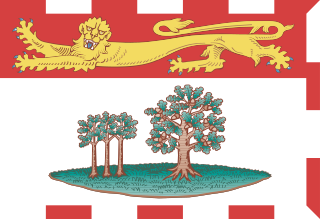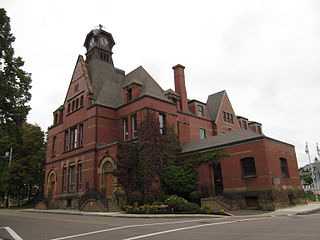
Prince Edward Island is one of the thirteen provinces and territories of Canada. While it is the smallest province in terms of land area and population, it is the most densely populated. The island has several nicknames: "Garden of the Gulf", "Birthplace of Confederation" and "Cradle of Confederation". Its capital and largest city is Charlottetown. It is one of the three Maritime provinces and one of the four Atlantic provinces.

Summerside is a Canadian city in Prince County, Prince Edward Island. It is the second largest city in the province and the primary service centre for the western part of the island.
Kingsbridge Wind Power Project, also referred to as Kingsbridge 1 Wind facility , refers to a large wind farm owned and operated by Capital Power Corporation. Kingsbridge 1 Wind facility is located between Goderich and Kincardine, Ontario. The Kingsbridge 1 Wind facility is located on the southeast shore of Lake Huron in the township of Ashfield-Colborne-Wawanosh and consists of 22 1.8 MW Vestas V80 wind turbines with a capacity of 39.6 MW. Each tower is over 78 meters tall and weigh around 195 metric tonnes. The project consists of two phases and currently provides power to on average 12,500 homes.

Windy Hill Wind Farm is a wind power station near Ravenshoe on the Atherton Tableland, Queensland, Australia. It has 20 wind turbines with a generating capacity of 12 MW of electricity, providing enough power for about 3,500 homes. The cost of the project was A$20 million. It was the second wind farm to be constructed in Queensland after the 0.45Mw station on Thursday Island (1997).

Hybrid power are combinations between different technologies to produce power.

The production of renewable energy in Scotland is a topic that came to the fore in technical, economic, and political terms during the opening years of the 21st century. The natural resource base for renewable energy is high by European, and even global standards, with the most important potential sources being wind, wave, and tide. Renewables generate almost all of Scotland's electricity, mostly from the country's wind power.
Wind power has a history in Canada dating back many decades, particularly on prairie farms. As of December 2021, wind power generating capacity was approximately 14,304 megawatts (MW). Combined with 2,399 MW of solar power generating capacity, this provided about 6.5% of Canada's electricity demand as of 2020. The Canadian Wind Energy Association (CanWEA) has outlined a future strategy for wind energy that would reach a capacity of 55 GW by 2025, meeting 20% of the country's energy needs.

The European Marine Energy Centre (EMEC) Ltd is a UKAS accredited test and research center focused on wave and tidal power development, based in the Orkney Islands, UK. The centre provides developers with the opportunity to test full-scale grid-connected prototype devices in wave and tidal conditions.

Elmira is a community in the Canadian province of Prince Edward Island, located in Lot 47 of Kings County, northeast of Souris.

Blyth Offshore Wind Farm was a small coastal wind farm located 0.5 miles (0.80 km) off the coast of Blyth, Northumberland, England.

The Bangui Wind Farm is a wind farm in Bangui, Ilocos Norte, Philippines. The wind farm uses 20 units of 70-meter (230 ft) high Vestas V82 1.65 MW wind turbines, arranged in a single row stretching along a 9-kilometer (5.6 mi) shoreline of Bangui Bay, facing the South China Sea.

In Japan's electricity sector, wind power generates a small proportion of the country's electricity. It has been estimated that Japan has the potential for 144 gigawatts (GW) for onshore wind and 608 GW of offshore wind capacity. As of 2023, the country had a total installed capacity of 5.2 GW.
The Papalote Creek Wind Farm near Taft, Texas in San Patricio County is an array of 196 wind turbines that can produce 380 megawatts (MW) of power, enough to serve approximately 114,000 homes. The wind farm was built and is operated by E.ON Climate and Renewables North America.
The Hampton Wind Park is a wind power station near Hampton, south-east of Lithgow, New South Wales, Australia. Initiated, developed and operated privately by a landholder, the farm has two wind turbines, with a total nameplate capacity of 1.32 MW of renewable electricity which is supplied to the main electricity grid.

Wind power in the Philippines accounts for a total of 443MW as of 2020 according to the Department of Energy, covering about 1.6% of the country's total installed capacity for both renewable and non-renewable energy sources. When it comes to existing renewable energy sources in the country, wind power has a total share of approximately 5.4%. Despite currently being a small contributor to the country's energy mix, wind power installations have increased from 33MW in 2012-2013 to 337MW in 2014, 427MW in 2015-2018, and 443MW in 2019-2021. Moreover, the Department of Energy's National Renewable Energy Plan (NREP) 2020-2040 aims to commission 2,345MW of total wind power capacity by 2030. There has been a setback, however, as the wind power industry was moderately affected by COVID, particularly in the import of wind turbines. Due to this, several projects such as the Aklan onshore wind project got delayed. To further drive the wind energy sector in the country, an increased demand for renewable energy, greater government commitments, and reduced wind power tariff are needed.

Wind power in Rhode Island is in the early stages of development. There are several small scale wind turbine projects in the state. As of December 2013 there were 11 turbines at 10 sites in the state. In 2014, Rhode Island had 9 MW of installed wind power capacity, which quickly rose to 75 MW in 2019.
Taiba N'Diaye Wind Power Station,, is a 158.7 MW (212,800 hp) wind power plant in Senegal. The power station is the largest wind power station in West Africa, by generation capacity.
The Ark was a bioshelter constructed in Spry Point, Prince Edward Island, designed by architects David Bergmark and Ole Hammarlund, who relocated from the USA to design the project under their firm's name Solsearch Architects. The other major contributor was a New England ecological research center, called The New Alchemy Institute, which conceptualized the PEI Ark. The goal of the New Alchemy institute was to study non-violent and non-lethal methods to secure the future of humanity as stated by one of the project's participants.




















